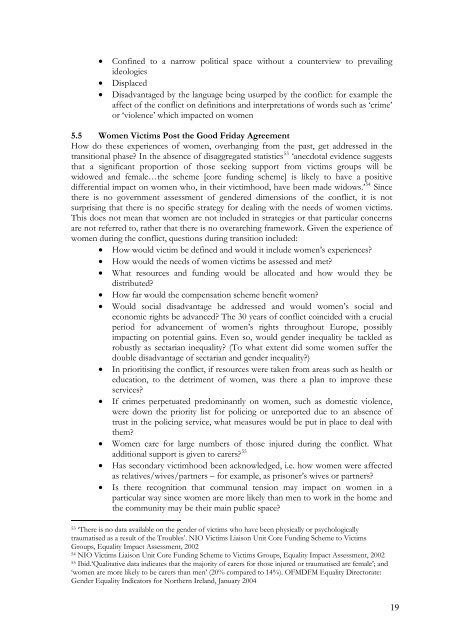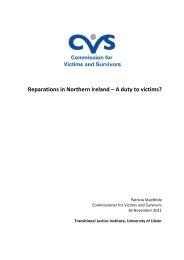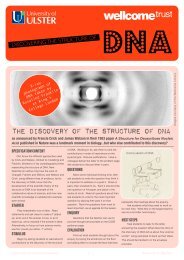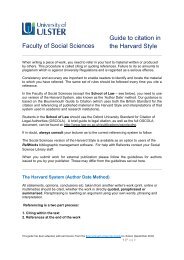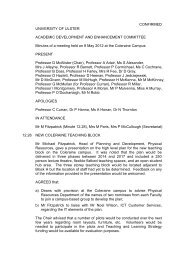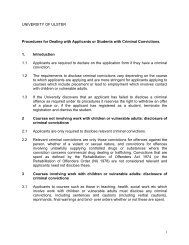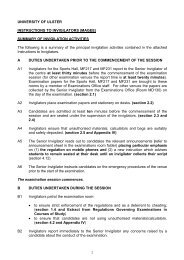Agreement Reached in the Multi-Party Negotiations - Transitional ...
Agreement Reached in the Multi-Party Negotiations - Transitional ...
Agreement Reached in the Multi-Party Negotiations - Transitional ...
Create successful ePaper yourself
Turn your PDF publications into a flip-book with our unique Google optimized e-Paper software.
• Conf<strong>in</strong>ed to a narrow political space without a counterview to prevail<strong>in</strong>g<br />
ideologies<br />
• Displaced<br />
• Disadvantaged by <strong>the</strong> language be<strong>in</strong>g usurped by <strong>the</strong> conflict: for example <strong>the</strong><br />
affect of <strong>the</strong> conflict on def<strong>in</strong>itions and <strong>in</strong>terpretations of words such as ‘crime’<br />
or ‘violence’ which impacted on women<br />
5.5 Women Victims Post <strong>the</strong> Good Friday <strong>Agreement</strong><br />
How do <strong>the</strong>se experiences of women, overhang<strong>in</strong>g from <strong>the</strong> past, get addressed <strong>in</strong> <strong>the</strong><br />
transitional phase? In <strong>the</strong> absence of disaggregated statistics 53 ‘anecdotal evidence suggests<br />
that a significant proportion of those seek<strong>in</strong>g support from victims groups will be<br />
widowed and female…<strong>the</strong> scheme [core fund<strong>in</strong>g scheme] is likely to have a positive<br />
differential impact on women who, <strong>in</strong> <strong>the</strong>ir victimhood, have been made widows.’ 54 S<strong>in</strong>ce<br />
<strong>the</strong>re is no government assessment of gendered dimensions of <strong>the</strong> conflict, it is not<br />
surpris<strong>in</strong>g that <strong>the</strong>re is no specific strategy for deal<strong>in</strong>g with <strong>the</strong> needs of women victims.<br />
This does not mean that women are not <strong>in</strong>cluded <strong>in</strong> strategies or that particular concerns<br />
are not referred to, ra<strong>the</strong>r that <strong>the</strong>re is no overarch<strong>in</strong>g framework. Given <strong>the</strong> experience of<br />
women dur<strong>in</strong>g <strong>the</strong> conflict, questions dur<strong>in</strong>g transition <strong>in</strong>cluded:<br />
• How would victim be def<strong>in</strong>ed and would it <strong>in</strong>clude women’s experiences?<br />
• How would <strong>the</strong> needs of women victims be assessed and met?<br />
• What resources and fund<strong>in</strong>g would be allocated and how would <strong>the</strong>y be<br />
distributed?<br />
• How far would <strong>the</strong> compensation scheme benefit women?<br />
• Would social disadvantage be addressed and would women’s social and<br />
economic rights be advanced? The 30 years of conflict co<strong>in</strong>cided with a crucial<br />
period for advancement of women’s rights throughout Europe, possibly<br />
impact<strong>in</strong>g on potential ga<strong>in</strong>s. Even so, would gender <strong>in</strong>equality be tackled as<br />
robustly as sectarian <strong>in</strong>equality? (To what extent did some women suffer <strong>the</strong><br />
double disadvantage of sectarian and gender <strong>in</strong>equality?)<br />
• In prioritis<strong>in</strong>g <strong>the</strong> conflict, if resources were taken from areas such as health or<br />
education, to <strong>the</strong> detriment of women, was <strong>the</strong>re a plan to improve <strong>the</strong>se<br />
services?<br />
• If crimes perpetuated predom<strong>in</strong>antly on women, such as domestic violence,<br />
were down <strong>the</strong> priority list for polic<strong>in</strong>g or unreported due to an absence of<br />
trust <strong>in</strong> <strong>the</strong> polic<strong>in</strong>g service, what measures would be put <strong>in</strong> place to deal with<br />
<strong>the</strong>m?<br />
• Women care for large numbers of those <strong>in</strong>jured dur<strong>in</strong>g <strong>the</strong> conflict. What<br />
additional support is given to carers? 55<br />
• Has secondary victimhood been acknowledged, i.e. how women were affected<br />
as relatives/wives/partners – for example, as prisoner’s wives or partners?<br />
• Is <strong>the</strong>re recognition that communal tension may impact on women <strong>in</strong> a<br />
particular way s<strong>in</strong>ce women are more likely than men to work <strong>in</strong> <strong>the</strong> home and<br />
<strong>the</strong> community may be <strong>the</strong>ir ma<strong>in</strong> public space?<br />
53 ‘There is no data available on <strong>the</strong> gender of victims who have been physically or psychologically<br />
traumatised as a result of <strong>the</strong> Troubles’. NIO Victims Liaison Unit Core Fund<strong>in</strong>g Scheme to Victims<br />
Groups, Equality Impact Assessment, 2002<br />
54 NIO Victims Liaison Unit Core Fund<strong>in</strong>g Scheme to Victims Groups, Equality Impact Assessment, 2002<br />
55 Ibid.‘Qualitative data <strong>in</strong>dicates that <strong>the</strong> majority of carers for those <strong>in</strong>jured or traumatised are female’; and<br />
‘women are more likely to be carers than men’ (20% compared to 14%). OFMDFM Equality Directorate:<br />
Gender Equality Indicators for Nor<strong>the</strong>rn Ireland, January 2004<br />
19


